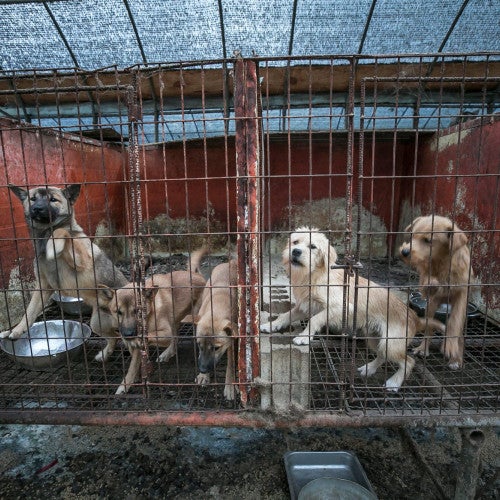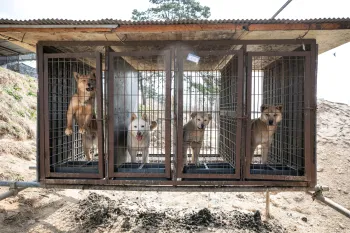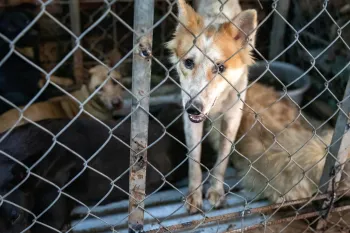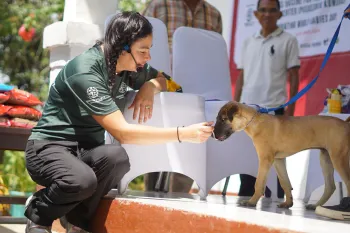How many dogs are killed in Asia’s dog meat trade each year?
An estimated 30 million dogs are killed for human consumption each year across Asia in a brutal trade that involves terrible cruelty to animals and often, criminal activity. This includes around 10 million dogs slaughtered in China, currently an estimated 460,000 in South Korea (as the industry is phased out in time for the 2027 ban to come into force), 1 million in Indonesia, around 3 million in Cambodia and around 5 million in Viet Nam; 80,000 or so of this last group are imported from Thailand, Laos and Cambodia. Accurate figures are impossible to obtain, as the dog meat trade is entirely unregulated and often illegal.
Which countries still eat dog meat and take part in the dog meat trade?
Although generally dog meat is not widely consumed in any country, across Asia its consumption is most widespread in parts of China, South Korea, Viet Nam, Cambodia, Indonesia, Laos, Myanmar, and parts of northeastern India such as Nagaland. This trade is well-organized, with high numbers of dogs being stolen or taken from the streets, transported over long distances and brutally slaughtered. In South Korea, dogs are also intensively farmed for the meat trade in appallingly deprived conditions. Dogs are also known to be eaten in certain African countries such as Ghana, Cameroon, DRC and Nigeria, and there are reports that dogs are killed for personal consumption by some farmers in remote parts of Switzerland, but this is by no means common practice.
Are dogs stolen from homes and streets for the dog meat trade?
In most Asian countries where this trade exists (with the exception of South Korea) the majority of dogs killed are either family pets stolen from homes and backyards , roaming "community" dogs or strays snatched from the streets. Dog and cat thieves use a variety of methods, including poison, and sell the animals to traders and restaurant owners. It is quite common to find dogs on trucks headed to slaughterhouses still wearing their collars.
Latest opinion poll data commissioned by Humane World for Animals Viet Nam shows that 87% of people in the country have either experienced their pet being stolen or have an acquaintance who has had their pet stolen. Dog thieves, armed with machetes and tasers, are hired by dog butchers to supply dogs.
This increase in illegal and violent activity with inadequate laws or enforcement to protect people’s ‘property’ has resulted in unprecedented vigilante behaviour. Reports on dog thieves being seriously injured and even killed by furious villagers are becoming increasingly common, and the media and social media in Vietnam have been flooded with clips of vigilante attacks against dog thieves.
How do dogs suffer in the dog meat trade?
Yes. Severe animal suffering is endemic to the dog meat trade. The animals are crammed by the hundreds onto the backs of trucks, packed so tightly in cages that they are unable to move. In Viet Nam, it is not uncommon for dogs to be violently force-fed with a tube down the throat in order to boost their weight before sending them to slaughter.
Dogs are typically driven for days or weeks, often sick and injured, and many die from suffocation, dehydration or heatstroke long before they reach their destination. Dogs on South Korean meat farms are kept locked in small, barren metal cages, left exposed to the elements and given just enough food, water or shelter to keep them alive. Humane World for Animals has uncovered appalling conditions where disease and mental distress are rampant, with many dogs showing obvious signs of sickness, depression, severe malnutrition and abnormal behavior.
All of these dogs will eventually end up at a slaughterhouse, market or restaurant. The method by which they are killed varies: in South Korea, the most common method for slaughtering a dog is by electrocution, but hanging and beating are also used. In China and Viet Nam, dogs are usually beaten to death with a metal pipe and then bled out from a cut to the throat or groin, but they can also be hanged, or—less commonly—thrown conscious into large drums of boiling water.
Is eating dog meat common or popular in Asia?
No, dog meat is not widely eaten or considered mainstream in most of the countries where the trade persists. Most people in China do not eat dog meat, and is not part of mainstream Chinese culinary culture. Even in the city of Yulin, where the annual dog meat "festival" takes place, a 2025 public survey reveals that 87.5% of respondents have never or rarely consume dog or cat meat and most people say that a dog meat ban would have no impact on their lives. There is a growing animal protection movement in the country that roundly opposes the dog meat trade, and there are frequent and documented violent clashes between dog thieves and angry dog owners.
In South Korea a 2023 opinion survey revealed that most South Koreans (867.5%) don't eat dog meat and 56% support a ban. Dog meat is most likely to be consumed by older generations and for perceived health benefits, particularly during the “Bok Nal” days of summer; younger South Koreans are far more likely to shun it. Polls show that the majority of under-30-year-olds have never eaten dog meat. Of those under-30s who do eat dog, the most cited reason is societal pressure, “because family members eat it.” Despite declining participation in dog meat eating, societal acceptance of others’ perceived right to eat it remains relatively strong.
Viet Nam is somewhat unusual in Asia in terms of the relative popularity of dog meat. An opinion poll commissioned by Humane World for Animals in October 2023 shows that dog meat is consumed by nearly 40% of the Vietnamese population, more popular than cat meat at 21%. As is typical across countries in Asia where dog meat is consumed, it is most popular in Viet Nam amongst men. Geographically, it is most popular in the north of the country, especially in hotspot areas such as Thai Nguyen. Despite this, there is considerable national support for a ban on the dog and cat meat trade in Viet Nam, particularly among women, young people and people who live in the south of the country. Nationally, 64% and 68% of people respectively support a ban on dog meat consumption and the dog meat trade, and 71% of people support a ban on both cat meat consumption and trade. By far the top reasons for not consuming dog and cat meat are a belief that they are companion animals and an aversion to animal cruelty.
A Nielsen opinion poll in January 2021, commissioned by the Dog Meat Free Indonesia coalition of which Humane World for Animals is a member, revealed that 93% of Indonesians support a national dog meat ban with fewer than 5% having ever consumed dog meat. Despite this, demand in some areas of the country continues to drive the trade. In some areas, such as North Sulawesi, dog meat is considered a traditional type of food and is most popular amongst Batak and Christian populations. Its consumption is often linked to certain religious ceremonies as well as festivities or events including Thanksgiving and family celebrations such as weddings and baptisms. As in many other parts of Asia, dog meat is also consumed in the mistaken belief that it has health properties, such as curing skin problems, dengue fever and asthma, as a general boost for the immune system, or improving male stamina. Contrary to common misconception, dog meat is not eaten because it is a cheap protein source, in fact it is no more or less expensive than other meats, although its consumption is often associated with that of alcohol.
What are the health risks of eating dog meat?
A significant threat to human health, the dog meat trade has been linked to outbreaks of trichinellosis, cholera and rabies. The World Health Organisation estimates that eating dog meat increases the risk of contracting cholera; a number of recent large-scale outbreaks in Viet Nam were directly linked to it.
Rabies—which kills thousands of people across Asia annually—has been found in dogs traded for human consumption in China, Viet Nam and Indonesia. As the dog meat trade involves the mass and unregulated movement of dogs within and even between countries, it all too easily facilitates the movement of rabies-positive dogs to supply highly-populated cities that are often dog meat eating “hot spots”, including those areas that have worked tirelessly to secure a “rabies-free” status.
Such mass movement of dogs clearly undermines rabies control recommendations from leading human and animal health experts, including the World Health Organization (WHO), World Organisation for Animal Health (OIE) and the Food and Agriculture Organization of the United Nations (FAO). The unsanitary conditions of slaughterhouses and the unknown heath status of dogs slaughtered for consumption are of added and equal concern, with those involved in the dog meat trade – traders, slaughterers, vendors and consumers – at further risk of being exposed to rabies and other zoonotic diseases.
Urge Indonesia’s president to end dog and cat meat trade
Call on President Prabowo Subianto to make Indonesia dog and cat meat-free.



